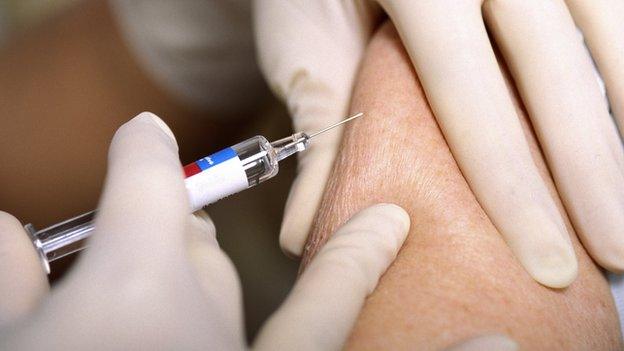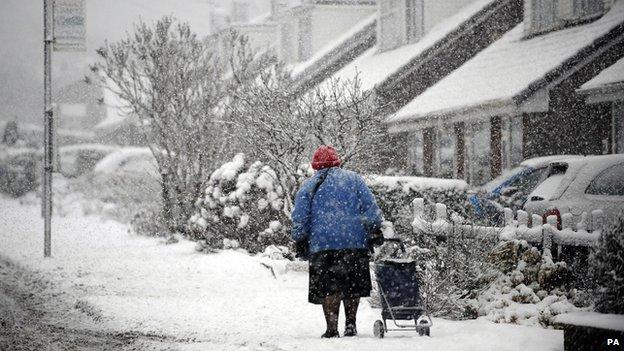Why flu vaccines are underperforming this winter
- Published

This year's flu vaccine is failing to adequately reduce the number of people contracting a prevalent strain of the virus, health officials have warned. Why is this?
Sometimes, the answer to why things happen is just bad luck. That is certainly the case for Britain and the flu.
Earlier this week, I reported how official figures had shown a spike in the death rate during January.
Around 3,000 extra people died each week in mid-January, compared to the average for those weeks for the past five years. That is a rise of about 30%.
Public Health England now says that the death rate has been elevated among the elderly population for seven weeks.
The suspected cause was mainly influenza. There was some early evidence for this - Britain has had an early flu season, hospitalisations are high, and a prevalent strain - H3N2 - is associated with grave consequences for the elderly, in particular.
And, Thursday evening, we got more evidence from a paper produced by scientists at Public Health England. This year, our flu vaccine is doing rather poorly.
'Poor result'
In a normal year, you would expect a vaccine to reduce the risk of contracting flu by about half.
Because the vaccine has struggled with the H3N2 strain, however, an article, external published in Eurosurveillance - a European epidemiology journal - says it has only reduced it by 3.4%. This is a poor result - and mirrored in other countries, too.
Flu vaccines are always based on a guess. Across the world, 141 countries contribute data and samples to a global flu surveillance system.

Based on that worldwide analysis of circulating flu types, the World Health Organization (WHO) makes recommendations to each hemisphere about what strains of flu are likely to be prevalent for their winter, and so deserve to go in vaccination programmes.
This year, the WHO recommended the same, main mix as last year - a type of H3N2 virus, a strain of H1N1 virus and a form of type B virus.
The problem this year has arisen with the H3N2 virus because the specific strain of it that the WHO advised we put into the vaccine does not quite match the type that is actually widely circulating.
Vaccine order 'placed last February'
That ineffectiveness has come about because of something known as "antigenic drift" - the viruses mutate such that they may stop matching up against the vaccines we have prepared for them.
This always happens. Vaccines are usually less effective at the end of the flu season than the start, because the viruses have had more time to change.
Indeed, a fundamental problem with our flu-fighting system is the lead times required for mass vaccine production, which forces us to pick strains very early in the year.
The six companies who produce UK vaccines make them between March and August, before they turn to making vaccines for the southern hemisphere season. There's no capacity to switch the vaccine at short notice.
That gap creates time for drift. For example, the report notes that the "drifted" H3N2 virus that is now in wide circulation was "first seen in North America in spring 2014, and then in Australia in mid-2014". The UK's vaccine order for this year was placed in February.
This drifted strain is, however, quite similar to the subtype of H3N2 - which the WHO recommended be included in the southern hemisphere winter flu vaccine. Let us hope they have a bit more luck than us.
There are, however, no guarantees. As a paper, external published in Eurosurveillance on Thursday drily noted, "a universal vaccine covering all influenza A virus subtypes and protecting from potential pandemic strains would be ideal".
'Do not give up on vaccination'

So is it still worth getting vaccinated this year? Well, yes. Vulnerable people - the young, elderly and pregnant - should still get it.
The vaccine may be a little better than it now looks against H3N2 too - the confidence intervals on the effects of the vaccine are quite wide. It might turn out to be better than it looks. Let's hope.
Also, the other subtypes that our vaccine covers are still out there.
Crucially, do not give up on vaccination. This has been a rough year, but the scientists will return and try again for next year with new surveillance data. Bear with them.
And maybe think a bit harder about hygiene until the flu season is over.